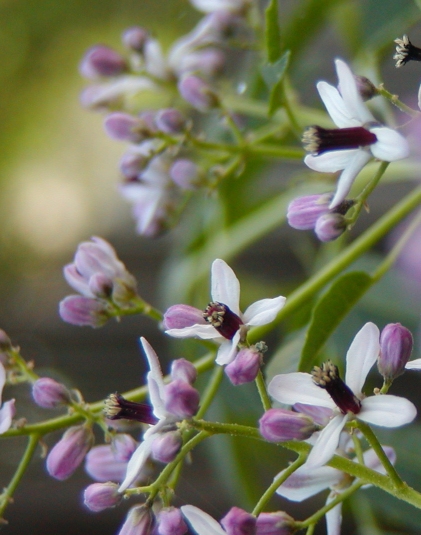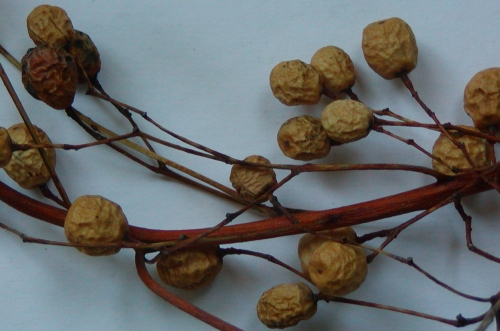Home Page
Meetings:
Minutes (pdf file)
Treasurer's Report (pdf file)
Agenda (pdf file)
Administration:
District Officers
By-laws &
Standing Rules
Protocols
Award Honorees
Conferences
History
Local Societies
Society Update Form
Personal Update Form
Logos
Newsletter (pdf file)
Public Gardens
Consulting Rosarians:
Consulting Rosarians
Annual Report Form
CR Status
Master Rosarian Form (pdf file)
How to become a Consulting Rosarian
Judges:
District Judges
Hort. Judges' Report Form
Arr. Judges' Report Form
Hort. Judge's Status
Arr. Judge's Status
Rose Shows:
District Trophies & Winners
Rose Show Results
Rose Culture:
District Roses in Review
Award of Merit Articles
District Rose Culture
Best Roses for the District
Misc:
Other Interesting Sites
Text Site Map
Award of Merit Winner
by DR. LAKSHMI SRIDHARAN
Member of the American Rose Society Research Committee,
Science Editor for the electronic American Rose Journal, and Horticultural Judge
I practically grew up with neem trees, Melia Azdirachta and Azadirachta indica. Neem belongs to the plant family, Meliaceae. In my native language Tamil, Melia Azadirachta is known as kattu vembhu (grows wild in forests, hence the name kattu vembhu; the Tamil word for forest is khattu). Azadirachta indica known as vembhu (Tamil name) is grown mostly in homes. My parent’s home in Chennai (formerly known as Madras), India, has a couple of neem trees. On hot summer afternoons, I used to sit under the tree and study for the final examinations in school. Indians believe that the breeze coming through the branches of neem tree has healing powers. The tree is known for its antiviral, antifungal, and antibacterial properties. Believe it or not, there is a popular belief that neem tree keeps the ghosts and evil spirits at bay! No wonder that almost every home in Madras has one or two neem trees. I felt that I should have a neem tree in my garden in San Jose, California to keep the insects and microorganisms away from my roses.
I like growing exotic plants from seeds. Two years ago, I brought seeds of Melia Azdirachta from Chennai. I chilled the seeds in the refrigerator for a month prior to sowing. Frost during winter in San Jose can almost kill tropical plants. I decided to induce winter hardiness in the seedlings hence was the chilling prior to sowing. I germinated them indoors. When the seedlings were 3 to 4 inches high, I placed them outside. I continued to expose them to harsh winter weather. I chose to grow two of them in two-gallon pots. When the plant was about 2-foot high, it started bearing fragrant white flowers with a tinge of lilac.

People of India use almost all parts of the tree for various medicinal and other purposes. We use dried neem flowers in tomato lentil soup (rasam in Tamil). Neem as a bactericide and a wormicide would kill the pathogenic bacteria and intestinal worms. Villagers brush their teeth with neem twigs. Toothpastes and soaps are made out of neem oil extracted from the kernels. I still remember the Margosa soap (Margosa is another popular English name for Neem) that I used while growing up in India. Neem oil is applied over wounds. Cattle are fed with neem cakes made out of neem oil. Neem cakes are used as a fertilizer.
As a pesticide, Neem oil plays an important role in the biological control of insects. While the Indians have been using the neem for centuries, the west has come to recognize the potential of neem oil in the control of insects in the last decade only. There is a growing concern in India about bio-piracy as a number of companies outside India are importing neem oil from India for use in their commercial products. The farmers and scientists in India are not happy about the western exploitation of neem trees.
You may wonder what exactly is responsible for the anti-microbial and pesticidal properties of neem. The biochemical compounds belong to a general class of natural products called "triterpenes", more specifically, "limonoids." Nine neem limonoids have demonstrated an ability to block insect growth in a wide variety of most deadly pests of agriculture and human health. the most significant of the so far discovered limonoids are azadirachtin, salannin, meliantriol, and nimbin.
Azadirachtin is mainly responsible for the insecticidal properties of the neem. Insects are perceptive to smell; they do not like the smell of neem oil. Azadirachtin disrupts the growth and reproduction in most of the pest. It is one of the most potent growth regulators. It will repel or reduce the feeding of many species of pest insects as well as some nematodes. In fact, it is so potent that a mere trace of its presence prevents some insects from even touching plants.
Azadirachtin is structurally similar to insect hormones called "ecdysones". Ecdysones which controls metamorphosis in the insects as they pass from larva to pupa to adult. It affects the corpus cardiacum, an organ similar to the human pituitary that controls the secretion of hormones. Metamorphosis requires a careful synchrony of many hormones and other physiological changes to be successful. Azadirachtin because of its structural similarity to ecdysone will block the ecdysone’s action in metamorphosis and the release of these vital hormones. Insects then will not molt. This of course breaks their life cycle.
Meliantriol in extremely low concentrations causes insects to cease eating. The demonstration of its ability to prevent locusts chewing on crops was the first scientific proof for neem's traditional use for insect control on India's crops.
Salannin, the third triterpenoid isolated from neem inhibits feeding, but not the molting of insects. Laboratory and field tests indicated that Salannin deterred the feeding habit of migratory locust, California red scale, striped cucumber beetle, houseflies, and the Japanese beetle.
Two more neem components, nimbin and nimbidin, have been found to have antiviral activity. They affect potato virus X, vaccinia virus, and fowl pox virus. They could perhaps open a way to control these and other viral diseases of crops and livestock. I do not know how many gardeners raise livestock! Nimbidin is the primary component of the bitter principles obtained when neem seeds are extracted with alcohol. It occurs in sizable quantities-about 2 percent of the kernel.
Newly identified limonoids from neem include deacetylazadirachtinol function as antihormones. This ingredient, isolated from fresh fruits, appears to be as effective as azadirachtin in assays against the tobacco budworm, but it has not yet been widely tested in field practice. Research has shown that some of these minor neem chemicals even paralyze the "swallowing mechanism" and so prevent insects from eating. Two other compounds related to salannin, 3-deacetylsalannin and salannol, recently isolated from neem, also act as anti-feedants.
Each and every part of the tree contains the Bioactive compounds. However, the seed kernels contain the most concentrated and accessible compounds. Extraction of the compounds is mostly from the kernels and, to a lesser extent, from the pressed cake. Although the active ingredients are only slightly soluble in water, they are freely soluble in organic solvents such as hydrocarbons, alcohols, ketones, or ethers.

Gardeners, who live in tropical countries and have access to Neem kernels, can easily extract the compounds by a simple technique used by the Indian farmers. Crush and grind the kernels, place them in a cloth bag, pour boiling water into the bag and collect the extract as it emerges. You may use the crude extract with or without filtering. You may spray the filtrate to control the pests and plant diseases.
Water extracts of ground neem leaves are also very useful. I bring dried neem leaves from India and water extract the active ingredients, filter and spray rose plants whenever possible. I wish that I do it consistently to keep the pathogens at bay!
A number of neem-based products such as TRILOGYTM 90 EC, TRIACTTM 90EC and Green Light Rose DefenseTM are commercially available. Follow manufacturer’s instruction when using any of these products. Since the bioactive compounds have deleterious effect on the insects that chew the leaves, they will not harm the pollinators and other beneficial insects.
One can easily grow neem trees in the warmer parts of the USA where the winter temperature does not go below the freezing point and elsewhere with winter protection. Years ago, I saw a neem tree growing in the backyard of a Hindu Temple in Houston, Texas. As mentioned earlier, I am growing a few of them in my backyard in San Jose. It does shed the leaves in winter, but bounces back in spring.
Seed propagation is the usual method of propagating a neem. In India, the crows eat the ripe neem fruits and pass the seeds through the digestive system. The bird-drops disseminate the seeds; the seeds germinate wherever the crows drop them! Laboratories at the Agricultural Universities in India do clonal propagation also. With a plant permit from the USDA, you may import seeds from India or carry a seedling from India. While waiting for my flight at the Madras Airport, I saw a German lady carrying a neem seedling! Once established, it does not need frequent watering or fertilizing.
If you like growing exotic plants as I do, you should certainly try growing this great tree for all the benefits you can get out of it. You do not have to pamper it as would pamper a rose plant. I am more than willing to share the seeds with anyone interested in growing it.
Last updated: 3/7/09
©NCNH District
All Rights Reserved
Webmaster: gailtrimble@ncnhdistrict.org